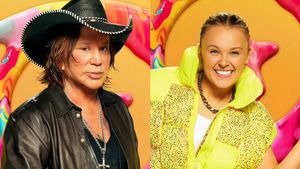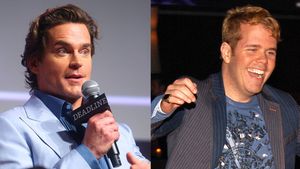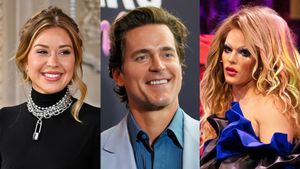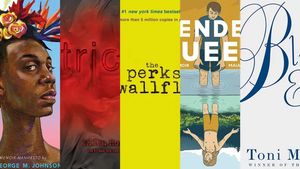Back in the
1980s, Billy Crystal's Fernando character on
Saturday Night Live claimed, "It's
not how you feel, it's how you look!" He was on
the right track, except that how one feels can be
equally important, as you will see.
What image comes
to mind when someone says "transgender"?
RuPaul? Klinger from the TV series M*A*S*H? Dr.
Frank 'N' Furter from the movie The
Rocky Horror Picture Show? Bree, Felicity
Huffman's character in the movie Transamerica?
Leslie Feinberg or Kate Bornstein?
These are all
examples of people whose gender expression (how one looks)
and gender identity (how one feels) can be problematic in a
"pink or blue" society. Actually,
"problematic" is an understatement. Every
month more than one person is murdered just for being
gender-nonconforming--and those are only the
cases we know about. This grim figure represents a
strikingly large percentage of a relatively small and
little-known population.
In the late 1980s
the word transgender was coined as an umbrella
term to refer to all gender-variant people. That's
one expansive umbrella! It covers drag queens and drag
kings, cross-dressers, transsexuals, gender-queer
people, and probably some others I don't even
know about yet. Even some gay men and lesbians with
nontraditional gender expressions may be protected by
trans-inclusive nondiscrimination and employment laws.
Recognizing our
common struggle for civil rights--and our common
enemies--the gay and lesbian movement started adding
the T in the mid 1990s. But my experience has shown
that the average gay man or lesbian today knows very little
about the transgender community and truly wants to
know more.
So please allow
me shed a little light on trans terminology.
RuPaul is
probably the best known example of a "drag
queen." "Drag kings"--women
who perform in a male persona--are growing in
popularity too; Heywood Wakefield is one example.
(Drag originally meant "dressed as a
girl," but for those dressing as a boy, drab
didn't exactly draw an audience!) People who
"do drag" do it for fun, entertainment, and
sometimes to earn a livelihood. Drag queens and kings can be
gay, straight, or bi, but few ever feel the need to
medically transition genders as actress Alexis
Arquette is doing. So, for the drag community, the
issue is their right to their gender expression.
Klinger from
M*A*S*H is a widely known example of a
"cross-dresser," at least among those of my
generation. People cross-dress for various reasons. In
Klinger's case he was making a political
statement. Dr. Frank 'N' Furter was doing it
for fetishistic reasons. Women started wearing
men's clothes awhile ago as a fashion
statement, and today that is commonplace. But put a guy in a
dress and it's still a huge deal! So men
who have a yet-to-be-explained need to cross-dress
often have to limit their dressing to the privacy of
their homes or to one of the various transgender
conferences held around the country each year.
Cross-dressers can also be gay, straight, or bi, but
they don't feel the need to medically
transition. Regardless of the reasons why they cross-dress,
the issue is their right to their gender expression.
Bree (Felicity
Huffman's character) is an example of a
"transsexual," as am I. We represent the
small part of the transgender population who feels so
strongly about being the gender opposite of our
'original' sex organs that--if we
can afford it--we take medical steps (hormone therapy
and/or surgery) to bring our physical bodies (how we
look) into alignment with our gender identity (how we
feel).
Many others who
have a strong contra-gender identity also
"transition" to live in their preferred
gender, using clothing, makeup, and mannerisms. These
people are "transgender" instead of
transsexual. Yes, you read correctly--medically
transitioning is only important for a small number of
people under the transgender umbrella. (More about that in a
future column.)
I identify as a
lesbian, but transsexual and transgender people can be
lesbian, gay, bi, or straight. Our issue is our right to
both our gender expression and gender identity.
Leslie Feinberg
and Kate Bornstein are real-life examples of the balance
of the transgender population. For them, the gender binary
does not work for their daily lives, either in part or
in the whole. It happens that both are writers, and
Feinberg's Stone Butch Blues and
Bornstein's Gender Outlaw are often
included in college gender studies curricula these days
because they encourage the reader to reconsider the
entrenched gender binary.
Perhaps as a
result of this, there is an increase in younger people
coming out as "gender-queer," which is pretty
much defined however the person wants. It can mean
some of one gender and part of another, or even none
of the above. Their issue is definitely their right to both
their gender expression and gender identity.
So what about
you? You likely don't consider yourself transgender.
But is how you feel and how you look important to you?
A butch lesbian does not think of herself as a man
(identity) because of her look (expression), nor does
a nelly gay man think of himself as a woman because of his
actions.
So I say that,
unlike what Billy Crystal's character purported, both
how one feels and how one acts and looks is critical
to one's self-definition. And regardless of
whether you consider yourself transgender, we
certainly have issues in common that give us a good
reason to work together.


















































































Here's our dream all-queer cast for 'The White Lotus' season 4